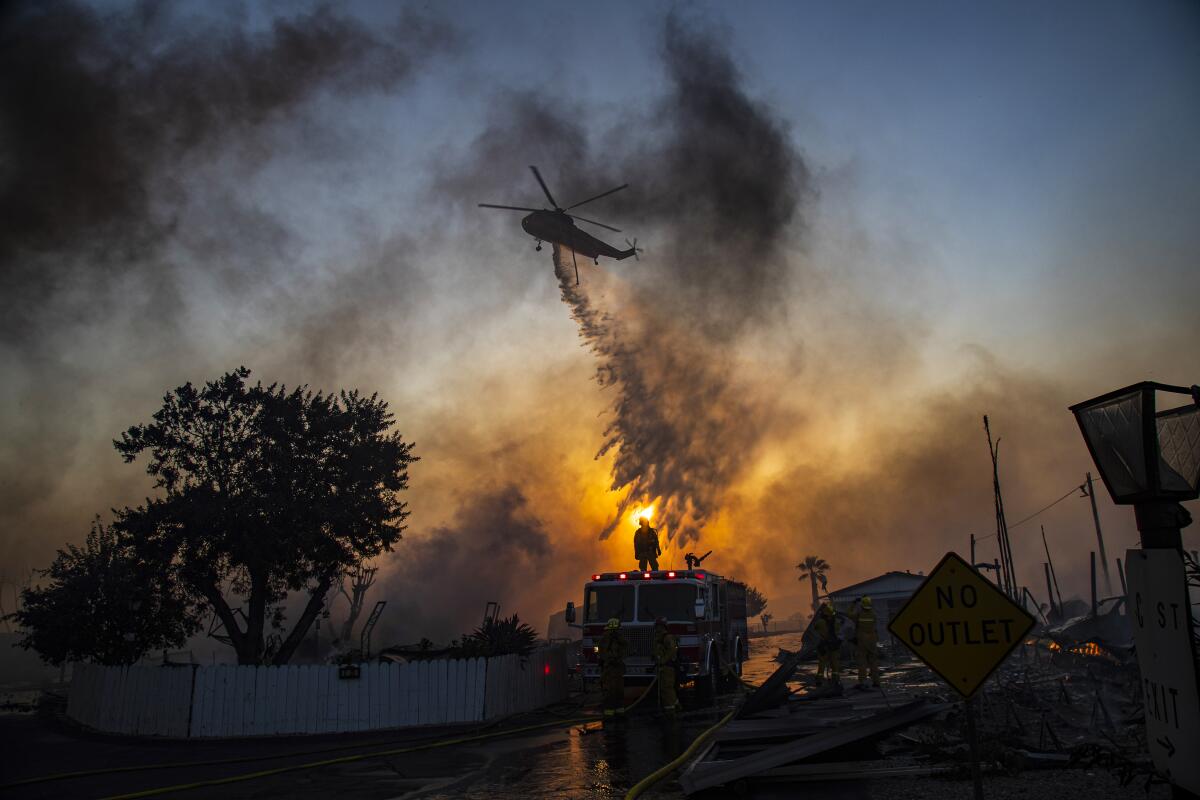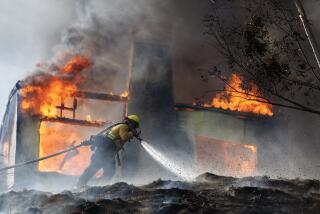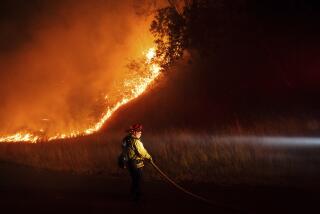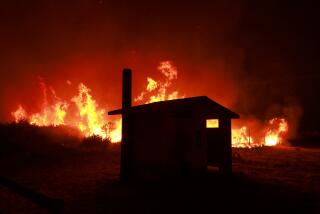California unveils sweeping wildfire prevention plan amid record fire losses and drought

SACRAMENTO — After the worst fire season in California history and as drought conditions raise fears of what’s to come, Gov. Gavin Newsom and legislative leaders unveiled a $536-million proposal Thursday to boost efforts at firefighting and a variety of prevention measures, including vegetation management and the construction of fire-resistant structures across the state.
The proposal, which the Legislature could send to the governor’s desk as soon as Monday, marks an early agreement by the governor and lawmakers to spend more than half of the $1 billion in wildfire funding Newsom called for in his state budget proposal in January. The gravity of the issue became clear last week after state officials reported the water content in the Sierra Nevada snowpack stood at 59% of the average for early spring.
“The science is clear: Warming winter temperatures and warming summer temperatures across the American West are creating more challenging and dangerous wildfire conditions,” said Wade Crowfoot, the governor’s secretary of natural resources.
According to an outline provided by legislative staff, more than $350 million will be spent on fire prevention and suppression efforts, including prescribed fires and other projects designed to reduce the vegetation growth that has fueled California’s most devastating fires. The package also includes $25 million for fortifying older homes that weren’t built using fire-resistance methods required during construction over the last decade.
“More suppression strategies, more prevention strategies, more regional, long-term, medium-term strategies,” Newsom said during an event in Fresno County. “And a greater sense of urgency than ever in contemporary California history.”
The agreement between Newsom, Senate President Pro Tem Toni Atkins (D-San Diego) and Assembly Speaker Anthony Rendon (D-Lakewood) more than doubles the funds in the governor’s original plan for new fire prevention grants administered by the California Department of Forestry and Fire Protection — and includes instructions that some of the money be prioritized for “projects that protect a larger population base,” according to bill language introduced Thursday. That provision could ensure a focus on fire threats across Southern California.
Paul Mason, vice president of policy and incentives for the Pacific Forest Trust, said the focus on regionalism is important.
“What we want to do in the forests of Northern California, where fires are driven by fuel, versus the chaparral of Southern California, where fires are driven by wind, are very different,” he said.
The new proposal adds significant muscle to that approach, Mason said.
“This is a huge amount of money,” he said of the $536-million package. “This is at least double what we’ve ever done as a state in the past.”
Lawmakers also significantly boosted funding for the Newsom administration’s plan to construct more fuel breaks across the state, replacing existing vegetation in fire-prone areas to change the speed or path of fire. And they added $36 million for fire resiliency and recovery efforts across conservancies from the Santa Monica Mountains to the San Diego River.
“For every dollar we spend on wildfire prevention, our state saves $6 to $7 in damage,” Atkins said in a written statement. “But it’s not just about saving money — this is about saving Californians’ lives, their homes, and their livelihoods.”
Newsom toured a fuel break site Thursday near Shaver Lake, a location near where the massive Creek fire scorched almost 380,000 acres beginning last September. On hand were National Guard crews deployed as part of a state fire prevention effort that began in 2019. The governor has also sought to boost the ranks of Cal Fire crews, announcing last month that almost $81 million in emergency funds would be used to hire close to 1,400 additional firefighters.
“It requires hand crews, it requires more personnel, but it requires intentionality, it requires a plan. And we have a plan,” the governor told reporters Thursday.
While the agreement to spend more than half a billion dollars came quickly by Sacramento standards, the state’s fire season is already underway. On Monday, firefighters responded to a brush fire in the Angeles National Forest, the third small blaze in the area since last weekend.
“This actually is an emergency, and we need to treat it as such,” said Michael Wara, director of the climate and energy policy program at Stanford University’s Woods Institute for the Environment. “What we see is a front-loading of spending, which I think is absolutely essential.”
More than 4 million acres were burned by wildfires in California last year, according to Cal Fire statistics . The year saw five of the six largest blazes in the state’s recorded history, none larger than the lightning-sparked blazes that became known as the August Complex fire — scorching more than 1 million acres in Mendocino, Humboldt, Trinity, Tehama, Glenn, Lake and Colusa counties.
Fire conditions this year could be even worse. Many of California’s largest reservoirs are only half full, and winter snow and rain in Northern California have been below their average level.
Most of the money earmarked in the proposal unveiled Thursday would come from California’s general fund, the state’s main bank account for government programs. Better-than-expected tax collections have already produced a multibillion-dollar windfall. The proposal relies on a smaller amount of money from proceeds of the state’s cap-and-trade program, in which companies pay for greenhouse gas emission credits.
Although a number of lawmakers want more of the climate change funds to be used for fire prevention efforts, the new agreement sidesteps the politically volatile issue and the likelihood that it might slow preparations for this fire season.
Though significant, Wara said Californians should view Thursday’s agreement as a good starting point. But he noted that Newsom’s push for $1 billion by the time this year’s budget negotiations are complete is unlikely to be enough to manage even 1 million acres of threatened lands in the year to come, with at least 10 million acres across California requiring fire prevention treatments.
“This is a good start, but this is only Year One,” he said. “We need sustained funding at this scale and maybe even larger for a decade.”
More to Read
Sign up for Essential California
The most important California stories and recommendations in your inbox every morning.
You may occasionally receive promotional content from the Los Angeles Times.











